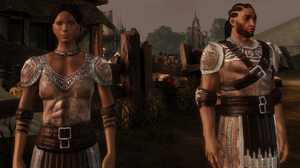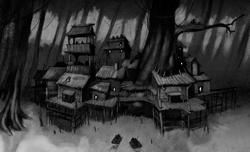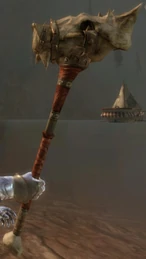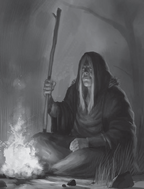m (fix links) Tag: apiedit |
Dalish-ious (talk | contribs) (Editing a gallery) Tag: gallery |
||
| Line 58: | Line 58: | ||
ChasindScout.png|Chasind Scout in ''[[Heroes of Dragon Age]]'' |
ChasindScout.png|Chasind Scout in ''[[Heroes of Dragon Age]]'' |
||
Chasind General.jpg|A Chasind General in ''[[Heroes of Dragon Age]]'' |
Chasind General.jpg|A Chasind General in ''[[Heroes of Dragon Age]]'' |
||
| + | Stoyanka.png|Old Stoyanka |
||
</gallery> |
</gallery> |
||
Revision as of 00:41, 29 May 2016

Male and female Chasind Wilders
The Chasind Wilders are a human tribe dating back to ancient times.
History
- When the Alamarri first passed into Ferelden from the distant west in 6185 FA or -220 TE TE,[1] some moved into the swampy forest vastness and the tundra beyond it to the south now known as the Korcari Wilds and became known as the Chasind, an enigmatic (albeit largely peaceful) people with shamanistic traditions and a great respect for magic.[2][3] Other accounts of this time refer to them as a strange twisted people plagued by dark desires, and the old tales state that after “countless winters” had passed since they parted from the other tribes of the Alamarri, the Chasind invaded the lands to the north accompanied by “white shadows” and twisted swamp creatures. They conquered the Alamarri for a time, though many of the tales dispute just how long this period lasted or even if the valley tribes were ever truly subjugated, before the Alamarri slaughtered the Chasind shamans who had called up the shadows with their magic, and drove their warriors back to the south. [4]
- In 1011 TE or -184 Ancient, The Tevinter Imperium's influence receded in southern Thedas as Minrathous rebuilt in the wake of the Second Blight[5], and the Chasind took this opportunity to claim the fortress of Ostagar, and ancient outpost built to watch out for Chasind incursions, but abandoned the fortress soon afterwards.[6]
- In 1:40 Divine following the defeat of the Darkspawn by the Alamarri (united under the warrior Hafter)[7][8], the Avvar and Chasind combine their forces and invade the lands held by the Alamarri, hoping to take advantage of the chaos.
- In 1:50 Divine Hafter finally defeats both the Avvars and the Chasind. Numerous battles were fought with both tribes, ultimately driving the Avvars deep into the Frostback Mountains and the Chasind back into the Korcari Wilds.[9][10]
- In the Towers Age, the legendary witch Flemeth rose as a terrible power amidst the Chasind. Her daughters, the Korcari witches, led an army of wilders and other, more terrible things, against the north. They were all but unopposed until the hero Cormac led an army of Alamarri fighters and Orzammar dwarves. After a long series of dreadful battles, the Chasind were all but destroyed, and the witches burned. To this day the Fereldans eye the south warily, regarding the Chasind with suspicion and hatred.[11]
- In 9:30 Dragon Age, the Fifth Blight begins in the Korcari Wilds, driving many Chasind refugees from their homes and north into Ferelden.[12]
Culture
While the Chasind have waged war on both the Tevinters and on the inhabitants of Ferelden in the past, today they are a largely peaceful people, although they are still viewed as primitive and barbaric by the people of Ferelden. They try their best to live out decent, if misunderstood, lives in the Wilds, painting their faces and banding together in small communities led by shamans.[13]
There are many tales of these shamans having learned their magic from the "Witches of the Wilds", witches that inspire as much terror as they do awe and gratitude even if there is no definitive proof they exist. In particular, the tale of Flemeth, the greatest witch of the wilds, is celebrated amongst all tribes.[14]

The village of Dosov, showcasing Chasind architecture
Chasind live out their lives in small villages made up of houses and strange-looking huts built on stilts, or even into the great treetops of the Korcari Wilds. Some Chasind are even said to eke out an existence in the frozen wastes that await beyond the Wilds, and to this day the Ferelden eye the south warily, regarding the Chasind with suspicion and hatred and fear the day a charismatic figure will unite them once again.[15][16][17]
Chasind respect those with survival skills in the Wilds[18], and have designed a system of leaving behind hidden markers and signs in piles of stone and rubble. In this way, they mark trails, note places of interest, and even give warnings in a way outsiders cannot understand. Interestingly, these markers look indistinguishable from a regular pile of stones[19].

A Chasind Maul, shaped to resemble an animal
Much of Chasind culture is a mystery, but they are known for their animistic beliefs, their tendency towards supersitition and that they do believe in the presence of gods of some kind. In particular they believe that some men or women are beloved of the gods, and some of their weapons have thus been shaped into the likeness of animals; the theory being that, upon a Chasind slaying someone with said weapon, the gods would be confused and might blame the animal that the weapon is modelled after instead.[20]
Other Chasind weapons, like their bows, also tend to bear strange markings and symbols[21], often inspired by nature[22]. Chasind are also known for their brawn, as many of their weapons require great strength to be used effectively in battle[23]. However, one of their most valued weapons are the flatblades, swords that are only given to the most prominent of their warriors. Indeed, none but a few of their shamans know of how to craft such a weapon.[24]
Chasind works of art seem primitive at best; pendants and charms carved from the fangs, bones or claws of animals seem to be the most common[25][26], alongside fertility carvings[27]. Likewise, their clothing is perhaps of questionable quality, sometimes merely pieced together from ragged strips of leather and adorned with the teeth and bones of animals and smelling strongly of tanned hides and sweat[28]. Even their helmets are often designed more for intimidation, rather than protection[29].
However, Chasind are not ignorant when it comes to crafting. For example, the Chasind have found ways to induce hallucinations through extracts of the leaves of Deathroot[30], and their skill in Herbalism further allowed them to create the ice salves to protect themselves from the cold winters of the Wilds[31][32].
And their skills are not limited to herbal mixtures; the Chasind have founds ways to brew both mead[33] and an alcohol called Wildwine, which is not actually a wine but a grain alcohol made from ryott, a protein-rich crop valued throughout Ferelden, traded to them from southern villages[34]. Wildwine is much stronger than beer and is a favored beverage among the Chasind[35].
While most Chasind do tend to live peaceful lives, there are some among them that favour bloodshed. Hardened by the harsh conditions of the Wilds that do not suffer fools lightly, the primitive nature of the Wilders do incline some tribes to take by force or stealth anything they cannot grow or build for themselves - which is to say, almost everything worth having. Chasind raiders, known within Ferelden as “stalkers,” often slip out of the wilds traveling in small scavenging parties to search for easy targets amidst the freeholds of the south. The Wilders are famed (and cursed about) for their stealth and hunting skills, both of which they employ to track down suitable targets. They favor vicious ambushes using short bows with wickedly hooked arrows. Stalker groups are invariably small, to deflect attention, and likely to be lightly armored in patchwork leather, so as to move with speed.[36]
Some Chasind do not raid and kill out of necessity, however... some deliberately inflict slow and painful deaths on their victims, seemingly out of cruelty.[37] Indeed, some Chasind are reputedly so barbaric that they even consume the flesh of the dead.[38]
Known Chasind

Cahir
- Cahir, a torturer in service of Prosper
- Doomsayer, a man whose family was killed by darkspawn
- Velcorminth, war leader at the time after the Second Blight[39]
- Baba Zorya, a Chasind living in the Korcari Wilds[35]
- Old Stoyanka, a Chasind wisewoman living in the Korcari Wilds[40]
- It is implied that Morrigan's father, who is unknown, was likely of Chasind origin.[41]
Known Chasind settlements
- Dosov[35]
- Tombigbee, a secret city of the Chasind, nicknamed "stilt-city." Its location is known only to the Chasind. [42]




